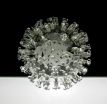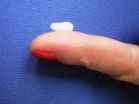(Press-News.org) Use of a radial artery (located within the forearm, wrist and hand) graft compared with a saphenous vein (from the leg) graft for coronary artery bypass grafting did not result in improved angiographic patency (the graft being open, unobstructed) one year after the procedure, according to a study in the January 12 issue of JAMA.
Coronary artery bypass grafting (CABG) is one of the most common operations performed, with a database indicating that in the United States, 163,048 patients had CABG surgery in 2008. The success of CABG depends on the long-term patency of the arterial and venous grafts. Arterial grafts are thought to be better conduits than saphenous vein grafts for CABG based on experience with using the left internal mammary (breast) artery to bypass the left anterior descending coronary artery, according to background information in the article. The efficacy of the radial artery graft, which is easier to harvest than other arteries, is less clear. A database shows that more than 10,000 patients in the United States received radial artery grafts in 2008, suggesting that about 6 percent of patients undergoing CABG have radial artery grafts.
Steven Goldman, M.D., of the Southern Arizona VA Health Care System and the University of Arizona Sarver Heart Center, Tucson, and colleagues compared 1-year angiographic patency of radial artery grafts vs. saphenous vein grafts in 757 participants (99 percent men) undergoing elective first-time CABG. The randomized controlled trial was conducted from February 2003 to February 2009 at 11 Veterans Affairs medical centers. The left internal mammary artery was used to preferentially graft the left anterior descending coronary artery whenever possible; the best remaining recipient vessel was randomized to radial artery vs. saphenous vein graft. The primary outcome measured was angiographic graft patency at 1 year after CABG. Secondary outcomes included angiographic graft patency at 1 week after CABG, heart attack, stroke, repeat revascularization and death.
The analysis included 733 patients (366 in the radial artery group, 367 in the saphenous vein group). The researchers found that there was no significant difference in 1-year graft patency between radial artery (238/266; 89 percent) and saphenous vein grafts (239/269; 89 percent). Also, there was no significant difference in 1-week patency between patients who received radial artery grafts (285/288; 99 percent) vs. saphenous vein grafts (260/267; 97 percent), or in the other secondary outcomes. There was no difference in the number and types of adverse events, including serious adverse events.
"Although most clinicians assume that compared with vein grafts, arterial grafts have an improved patency rate, there are little multi-institutional prospective data on radial artery graft vs. saphenous vein graft patency," the authors write.
Because the important question is long-term patency, the researchers note that there will be a 5-year angiographic follow-up of these patients to define chronic graft patency in this population.
INFORMATION:
(JAMA. 2011;305[2]:167-174. Available pre-embargo to the media at www.jamamedia.org)
Editor's Note: Please see the article for additional information, including other authors, author contributions and affiliations, financial disclosures, funding and support, etc.
To contact Steven Goldman, M.D., call Katie Maass at 520-626-4083 or email KMaass@SHC.Arizona.edu.
For More Information: Contact the JAMA/Archives Media Relations Department at 312-464-JAMA or email: mediarelations@jama-archives.org.
For CABG, use of artery from arm does not appear to be superior to vein grafts from the leg
2011-01-12
ELSE PRESS RELEASES FROM THIS DATE:
Study finds more breaks from sitting are good for waistlines and hearts
2011-01-12
It is becoming well accepted that, as well as too little exercise, too much sitting is bad for people's health. Now a new study has found that it is not just the length of time people spend sitting down that can make a difference, but also the number of breaks that they take while sitting at their desk or on their sofa. Plenty of breaks, even if they are as little as one minute, seem to be good for people's hearts and their waistlines.
The study, which is published online today (Wednesday 12 January) in the European Heart Journal [1], is the first in a large, representative, ...
Acne bug could be the cause of your infections
2011-01-12
Previously, researchers thought the detection of P. acnes at the site of these infections was due to contamination from the skin. For example, an infection at a site within the body after surgery, could have been caused by bacteria transferred to an open wound from the skin during an operation. But recent research has contradicted this, suggesting P. acnes already within the body, may be the cause. Although it is often disregarded as a harmless bystander when found in blood and tissue swabs taken from patients, we should not rule out this bug in the diagnosis of disease.
People ...
New method for reporting solar data
2011-01-12
Washington, D.C. (January 11, 2011) -- A straightforward new way to calculate, compile, and graphically present solar radiation measurements in a format that is accessible to decision makers and the general public has been developed by researchers at the University of Texas at Austin.
The method presents solar data in a framework that "can be used by policymakers, businesses, and the public to understand the magnitude of solar resources in a given region, which might aid consumers in selecting solar technologies, or policymakers in designing solar policies," says David ...
Trapped sunlight cleans water
2011-01-12
Washington, D.C. (January 11, 2011) -- High energy costs are one drawback of making clean water from waste effluents. According to an article in the journal Biomicrofluidics, which is published by the American Institute of Physics, a new system that combines two different technologies proposes to break down contaminants using the cheapest possible energy source, sunlight. Microfluidics – transporting water through tiny channels -- and photocatalysis -- using light to break down impurities – come together in the science of optofluidics.
"These two technologies have been ...
Off-the-shelf electronics turn up gain on spectroscopy
2011-01-12
Washington, D.C. (January 11, 2011) -- Whether the object of attention is a novel aspect of the universe or an enigmatic and distant colleague, listening is key to nearly any effort to seek understanding. And not just with your ears. Spectroscopy, the study of how atoms absorb and emit electromagnetic radiation, is like listening, too. The technique is central to a range of physics experiments and can be thought of as an attempt to filter out useful information from what various sensors and detectors often first "hear" as undifferentiated electromagnetic noise.
Now, ...
New research aims to shut down viral assembly line
2011-01-12
Under the electron microscope, a coronavirus may resemble a spiny sea urchin or appear crownlike, (the shape from which this family of pathogens takes its name). Previously recognized as the second leading cause of the common cold in humans and for economically important diseases in many domesticated animals, a new disease form abruptly emerged as a major public health concern in 2002, when the SARS coronavirus (CoV) surfaced in Asia.
The rapid spread of the virus caused significant social and economic disruption worldwide , infecting over 8000 people with Sudden Acute ...
New MS target identified by Canadian researchers
2011-01-12
Multiple sclerosis (MS) is a disease caused by damage to myelin – the protective covering wrapped around the nerves of the central nervous system (CNS).
Previous studies have shown that certain white blood (immune) cells, called leukocytes, infiltrate the CNS and play a significant role in causing the damage that contributes to MS symptoms. It has also been shown that these leukocytes enter the CNS with help from a family of molecules called MMPs.
Using a mouse model, researchers have discovered that a molecular switch called EMMPRIN plays an important role in MS. The ...
Cell Transplantation reports a success in treating end-stage liver disease
2011-01-12
Tampa, Fla. (Jan. 10, 2011) – Transplanting their own (autologous) bone marrow-derived stem cells into 48 patients with end-stage liver disease resulted in therapeutic benefit to a high number of the patients, report researchers publishing in the current issue of Cell Transplantation (19:11). Yet, the mechanism by which the infusion of CD34+ stem cells improves liver function remains elusive, they say.
The study, carried out by a team of researchers in California and in Egypt, is now freely available on-line at http://www.ingentaconnect.com/content/cog/ct/.
According ...
International first: Gas-phase carbonic acid isolated
2011-01-12
A team of chemists headed by Thomas Loerting from the University of Innsbruck and Hinrich Grothe from the Vienna University of Technology (TU Wien) in Austria have prepared and isolated gas-phase carbonic acid and have succeeded in characterizing the gas-phase molecules by using infrared spectroscopy. The results were published in the journal Angewandte Chemie International Edition.
In textbooks and other media the widespread belief still prevails that stable carbonic acid cannot be produced in pure form and is practically non-existent as it immediately decomposes to ...
'Taking children seriously'
2011-01-12
Small children are capable of engaging in issues concerning sustainable development.Their interests and rights must be better safeguarded in rules and policy decisions that concern the education of the youngest groups of children within the EU.
This is emphasised in the report "Taking children seriously – How the EU can invest in early childhood education for a sustainable future", which was presented at a seminar in Brussels on Friday 17 December.
The body behind the report is the European Panel on Sustainable Development (EPSD), an independent research-based network ...


